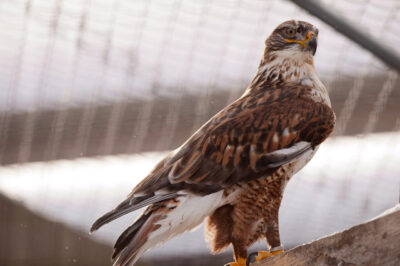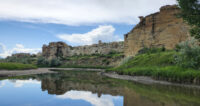Province launches plan to protect endangered hawk
By Al Beeber - Lethbridge Herald on February 22, 2024.
 Canadian Press file photo -
A ferruginous hawk is shown at Forestry Farm Park and Zoo in Saskatoon.
Canadian Press file photo -
A ferruginous hawk is shown at Forestry Farm Park and Zoo in Saskatoon.LETHBRIDGE HERALDabeeber@lethbridgeherald.com
The province of Alberta on Wednesday announced a plan to protect the endangered ferruginous hawk.
Known as the largest of its species in North America, the ferruginous hawk has long been seen in southern Alberta’s grasslands.
But despite efforts to increase its numbers, the bird is still deemed endangered under Alberta’s Wildlife Act.
A new plan unveiled by the government is aimed at protecting the hawk and increasing the population. It will be an update to the original 2014 plan and in addition to increasing numbers, it is aimed at protecting nesting sites and supporting habitats needed for the hawk to thrive.
The province says under its original plan, the hawk population has slowly stabilized and shown signs of increasing. But an updated approach is needed for long-term recovery.
In the new plan, the government and its partners across Alberta will work to support and protect habitats, nest structures and the prey needed for the birds to survive.
Other steps to be taken in coming years include reducing human disturbance at nesting sites and limiting the impact of predators.
The plan was developed with input from various sources including Indigenous communities, conservation groups and industry.
The hawks require an open habitat including grassland, shrub-steppe or desert. They typically nest on elevated features such as trees or nest platforms. Main predators include great-horned owls but nestlings can be subject to predation by golden eagles, coyotes, badgers and foxes.
“Ensuring grasslands are maintained for species like ferruginous hawks is crucial. These hawks are often embraced by landowners as a natural means to help control ground squirrel numbers, with many encouraging the endangered species to establish a nest on their land. Continued support and collaboration from landowners, along with society’s desire to see ferruginous hawks thrive, provides a promising future for this and other species as long as we maintain intact grasslands,” says Brad Downey, senior biologist with the Alberta Conservation Association, in a press release.
Data shows the the population in Alberta reached a low of about 600-700 breeding pairs in the mid to late 1990s and stayed at that level until 2015 when numbers began to increase.
“There is potential for recovery of the ferruginous hawk in Alberta. While the proximate and ultimate causes of the ferruginous hawk declines are not conclusively known, the declines appear to be linked to a number of contributing factors. Based on analysis and knowledge of the species, the Alberta Ferruginous Hawk Recovery Team has determined that the ferruginous hawk population can be recovered through appropriate management to reduce the threats to the species,” says the updated plan.
The recovery goal is to see a stable long-term average population of 1,300 pairs distributed across the province.
“The Alberta Ferruginous Hawk Recovery Plan 2009-2014 outlined recovery strategies and actions necessary for the recovery and conservation of ferruginous hawk in Alberta. Progress occurred on many recovery actions outlined in the plan, either through project-specific initiatives for the ferruginous hawk or as part of larger provincial initiatives,” states the updated plan.
“Seven recovery strategies were identified to recover the ferruginous hawk in Alberta: reduce human disturbance at nest sites, maintain existing native grasslands and pasture lands on both public and private land, ensure adequate number of nest structures are available in suitable habitat, maintain and enhance prey populations for ferruginous hawks, reduce human-caused mortality of ferruginous hawks in Alberta,
limit the impacts of predators and competing bird species, and conservation of ferruginous hawks during migration and on their wintering grounds.”
Recovery actions will be implemented in priority areas. Habitat needed to support recovery is defined as areas with the highest suitability or the potential to support the highest densities of ferruginous hawks. Recovery actions will be implemented through funding from a variety of sources, including in-kind and dedicated project funds from within government, industry, academia and non-government conservation organizations,” says the plan.
The revised plan was prepared by a recovery team comprised of people with knowledge about the species, organizations that are influential in management and recovery of the ferruginous hawk and stakeholders who may be impacted by recovery actions.
“Ferruginous hawks are migratory, arriving in Alberta in late March to early April to pair and then nest.Following fledging (mid-July), the young and adults remain near the nest for about one month, with young beginning their southward migration to the southern United States and Northern Mexico in August and adults leaving as late as mid-October,” says the government.
Birds face diverse mortality factors during migration with survival reduced, especially for juvenile hawks during their first migration and search for suitable wintering areas.
Breeding density and success in Alberta is linked to the distribution and abundance of Richardson’s ground squirrels which are the bird’s main prey. The government says the breeding distribution of ferruginous hawks in the province has declined by about 40 per cent since pre-settlement.
23-22





yes, increasing numbers is a brilliant plan! why do we not just use that simple “solution” for everything that is endangered? lol sure hope the plan includes habitat protection…and another idea might be to NOT poison the creatures that predators require in order to survive.
I was involved with groups in the late 80s through late 90s that were doing everything they could to improve the ferruginous hawks status, identifying and using pretty much the ideas noted in the article. This has been a long battle for these birds. Ongoing critical habitat loss continues to be a key reality across ferruginous hawks range. Too many acres of grasslands still get broken for crops; land that is marginal as cropland at best, but greed prevails and governments have been complicit in this ongoing travesty. I have also read studies that have determined that poisoning in the winter migratory destinations has caused many thousands of deaths some years.
Sadly poaching for illegal trade of bird parts has also been a tragic cause of the deaths of too many hawks.
Hats off to the folks working on the ground to conserve this species.